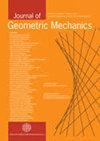规范理论中的修整场法。几何方法
IF 1
4区 数学
Q3 MATHEMATICS, APPLIED
引用次数: 0
摘要
最近,T. Masson, J. Francois, S. Lazzarini, C. Fournel和J. Attard提出了一种新的减少规范对称性的方法,称为修整场法。本文从纤维束的角度分析了这种方法,并给出了给定规范理论下的主束的几何含义。我们证明了满足一定条件的修整场的存在如何自然地导致主束的缩减,从而导致系统的构型和相束的缩减。本文章由计算机程序翻译,如有差异,请以英文原文为准。
The dressing field method in gauge theories - geometric approach
Recently, T. Masson, J. Francois, S. Lazzarini, C. Fournel and J. Attard have introduced a new method of the reduction of gauge symmetries called the dressing field method. In this paper we analyse this method from the fiber bundle point of view and we show the geometric implications for a principal bundle underlying a given gauge theory.We show how the existence of a dressing field satisfying certain conditions naturally leads to the reduction of the principal bundle and, as a consequence, to the reduction of the configuration and phase bundle of the system.
求助全文
通过发布文献求助,成功后即可免费获取论文全文。
去求助
来源期刊

Journal of Geometric Mechanics
MATHEMATICS, APPLIED-PHYSICS, MATHEMATICAL
CiteScore
1.70
自引率
12.50%
发文量
23
审稿时长
>12 weeks
期刊介绍:
The Journal of Geometric Mechanics (JGM) aims to publish research articles devoted to geometric methods (in a broad sense) in mechanics and control theory, and intends to facilitate interaction between theory and applications. Advances in the following topics are welcomed by the journal:
1. Lagrangian and Hamiltonian mechanics
2. Symplectic and Poisson geometry and their applications to mechanics
3. Geometric and optimal control theory
4. Geometric and variational integration
5. Geometry of stochastic systems
6. Geometric methods in dynamical systems
7. Continuum mechanics
8. Classical field theory
9. Fluid mechanics
10. Infinite-dimensional dynamical systems
11. Quantum mechanics and quantum information theory
12. Applications in physics, technology, engineering and the biological sciences.
 求助内容:
求助内容: 应助结果提醒方式:
应助结果提醒方式:


